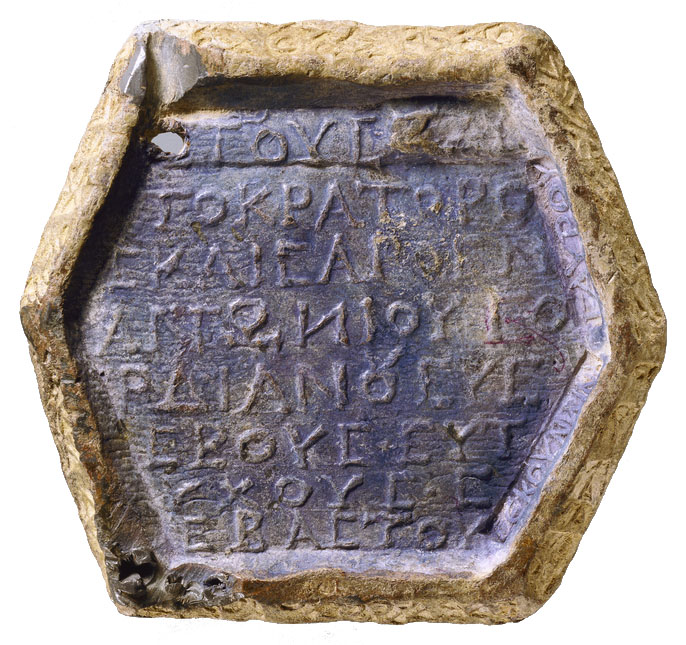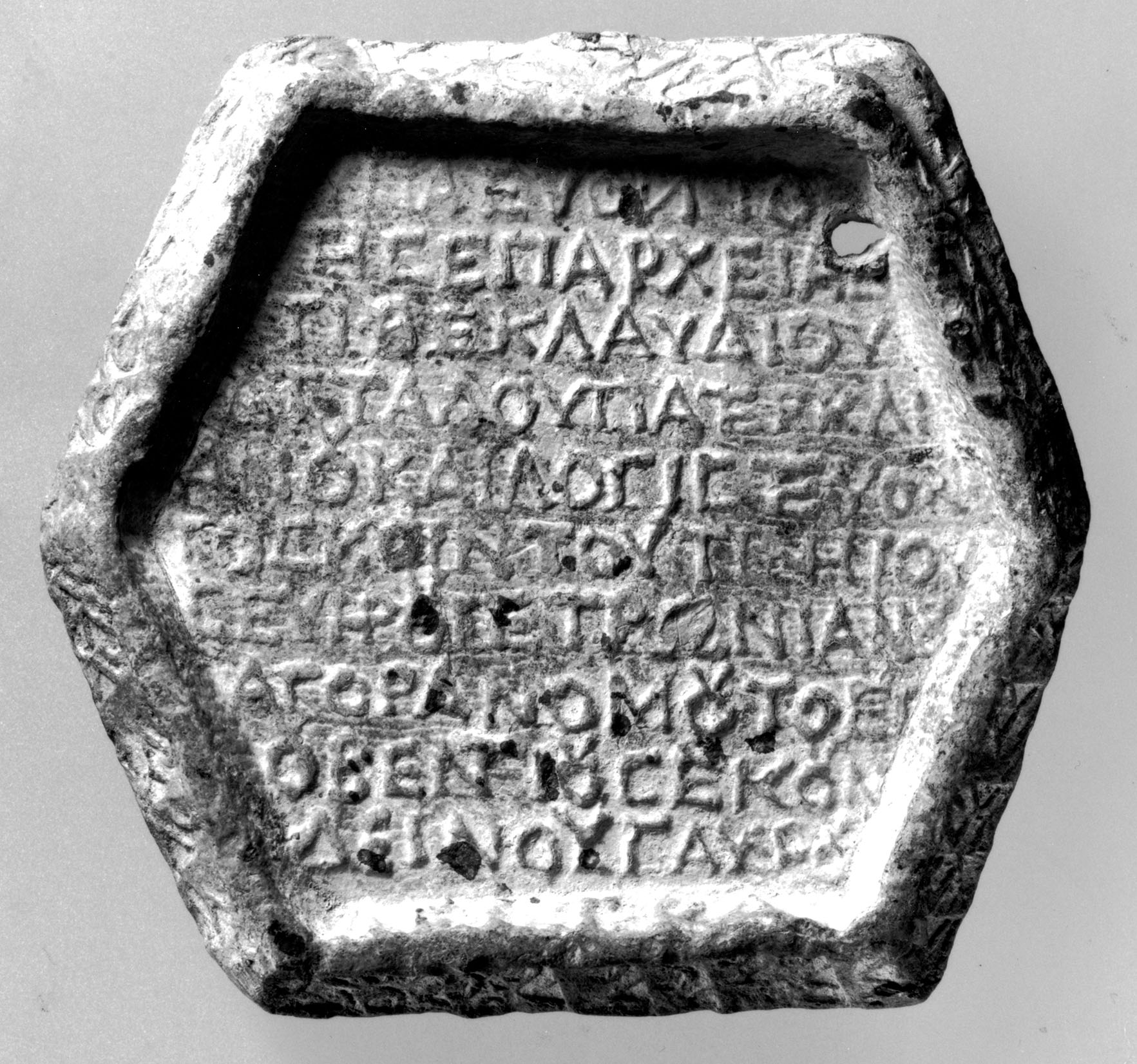
-
Copyright credit: J. Paul Getty Museum

-
Copyright credit: Barbara and Lawrence Fleischman

-
Copyright credit: Barbara and Lawrence Fleischman

-
Copyright credit: Haensch and Weiß 2005

ARCHAEOLOGICAL DESCRIPTION OF THE WEIGHT
Authority
Gordian III, Roman Emperor
;
Juventius Secundinus Gaurus, agoranomos (Nicomedia)
;
Q. Tineius Severus Petronianus, curator rei publicae (Nicomedia)
;
Ti. Claudius Attalos Paterclianus, governor (Pontus-Bithynia)
Mint
Nicomedia
Denomination
1 Libra = 1 Litra
Material
Lead
Manufacture
Cast
Shape
Polygon (pentagon, hexagon, heptagon, octagon, etc.)
Length
10.48 cm
(4.125 inch)
Width
11.11 cm
(4.375 inch)
Height
1.43 cm
(0.5625 inch)
Metrology
| Mass (g) | Mass (grain) | Date of measurement | Reference | fragmented | cleaned | reference weight |
|---|---|---|---|---|---|---|
| 506.62 | 7818.301 | - | www.getty.edu | No | No | Yes |
Iconography
| Symbol | Technique | Direction | Position | Number | Synecdoche |
|---|
Wear
Corrosion
Handle
No
Suspension hole
Yes
Recarved mould
No
Recarved weight
No
Intentionally destroyed
No
Archaeological description
Greek inscriptions cover both sides of this hexagonal Roman weight. They set out the order of authority descending from the emperor down to the governor of the province, the chief financial officer, and on to the agoranomos, the official who oversaw the accuracy of weights and measures used in the market. The inscription on the front of the weight also states that it was issued in the seventh year of the reign of the Roman emperor Gordian III, or A.D. 244. The identification of the provincial governor allows scholars to determine that this weight came from the province of Bithynia, located on the Black Sea in modern Turkey. The use of the Greek language is not unusual for parts of the eastern Mediterranean region, where Greek continued to be the language in daily use long after the Romans had taken over. But the Roman--rather than the Greek--weight system was used. This was an official litra weight used as a government standard. The unit is given by an inscription separate from the others on the rim of the weight.
Autopsy
No
INSCRIPTION
| Language | Technique | Legend type |
|---|---|---|
| Greek | Stamped / Countermarked / Struck | Authority |
| Greek | Relief | Authority, Date, Denomination |
Fac simile
Edition
Haensch and Weiß 2005: (Seite A) ἔτους ζ΄ Αὐ|τοκράτορο|ς Καίσαρος Μ(άρκου) | Ἀντωνίου Γο|ρδιανοῦ Εὐσ|εβοῦς Εὐτ|υχοῦς Σ|εβαστοῦ
(Seite B) ὑπατεύοντος | τῆς ἐπαρχείας | Τιβε(ρίου) Κλαυδίου | Ἀττάλου Πατερκλι|ανοῦ καὶ λογιστεύον|τος Κοίντου Τινηίου | Σεουήρου Πετρωνιανοῦ, | ἀγορανομοῦ(ν)το<ς> Ἰ|ουβεντίου Σεκουν|δείνου Γαύρου, | λείτρα (im Rand)
Kontrollstempel auf Seite A: Σεκουνδίνου und Γαύρου
Ligaturen
Seite A: Z. 4. NT, 5. OY
Seite B: Z. 1. TE, 2. TH, 4. TE, 5. OY, TE, 6. NH, 7. OY, TIE, OY, 8. OY, 9. OY,
NT, OY, OY, 10. OY
(Seite B) ὑπατεύοντος | τῆς ἐπαρχείας | Τιβε(ρίου) Κλαυδίου | Ἀττάλου Πατερκλι|ανοῦ καὶ λογιστεύον|τος Κοίντου Τινηίου | Σεουήρου Πετρωνιανοῦ, | ἀγορανομοῦ(ν)το<ς> Ἰ|ουβεντίου Σεκουν|δείνου Γαύρου, | λείτρα (im Rand)
Kontrollstempel auf Seite A: Σεκουνδίνου und Γαύρου
Ligaturen
Seite A: Z. 4. NT, 5. OY
Seite B: Z. 1. TE, 2. TH, 4. TE, 5. OY, TE, 6. NH, 7. OY, TIE, OY, 8. OY, 9. OY,
NT, OY, OY, 10. OY
Monogram
ARCHAEOLOGICAL CONTEXT
Findspot (region)
Findspot (site)
context
CIRCUMSTANCES OF ACQUISITION
Region
City
Date of first acquisition
circumstances
Gift of Barbara and Lawrence Fleischman (New York, 1925 - New York, 1997) to the J. Paul Getty Museum in 1996. Sold to Barbara and Lawrence Fleischman in 1990, Fritz Bürki & Son (Zurich, Switzerland).
DATING OF THE WEIGHT
Curatorial Section
GREEK
,
ROMAN
Time frame
FROM
243
TO
244
Comments on Chronology
Haensch and Weiß 2005: Gordianus III, 7. Jahr. Haensch and Weiß 2007: Dies imperii (oder mutmaßliches Äquivalent): Anf. V. (?) 238. Kaiserjahr entspricht wahrscheinlich: 23.IX.243 – 22.IX.244. Weiter datierende Angaben (nur die jeweils zeitlich letzte) : Tod. Ergibt : Anf. 244. Gesamtdatierung : 23.IX.243 – Tod im Jahr 244.
COLLECTION HISTORY
Collection
| Name | Date of acquisition | Inventory number |
|---|---|---|
| Fleischman Collection | Jan. 1, 1990 | F245 |
| Getty Museum – Getty Villa (Malibu) | Jan. 1, 1996 | 96.AI.202 |
Bibliography
| Reference | Page/Column | Reference (number) | Plate / Figure | Comment |
|---|---|---|---|---|
| AÉ 1993 | None | 1442 | None | None |
| Mildenberg 1994 | 319–320 | 166 | None | None |
| SEG 44 | 344–345 | 1008 | None | None |
| True and Hamma 1994 | 319–320 | 166 | None | None |
| Weiß 1994 | 362–367, 386 | II.4 | pl. 2/4 | None |
| Getty Museum 1997–98 | 69 | |||
| Marek 2003 | 103a, 103b | (non vidi) | ||
| Haensch and Weiß 2005 | 466–467, 490–491 | 7 | 7 | None |
| Haensch and Weiß 2007 | 211 | None | None | None |
| Haensch and Weiß 2014 | 545 | None | None | None |
VARIA
Additional comment
Permalink